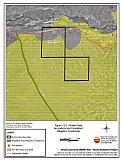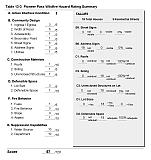13.0 Pioneer Pass
13.1 Risk and Hazard Assessment
Pioneer Pass is a subdivision about eight miles east of Beowawe. A fire burned through the subdivision in 1999. The community hazard assessment resulted in classifying Pioneer Pass in the Moderate Hazard category (57 points). The moderate hazard rating is primarily attributed to limited access, lack of water storage for fire suppression, limited fire suppression resources, and inadequate street and address signage. A summary of the conditions that contributed to the hazard rating for Pioneer Pass is included in Table 13-3 at the end of this section (Figure 13-1).
13.1.1 Community Design
Pioneer Pass has a classic wildland-urban interface condition with a clear line of demarcation between buildings and wildland fuels. Wildland vegetation typically does not continue into the development areas. All eighteen of the homes assessed in the interface area are on lots of between one and ten acres in size resulting in low density housing.
- Access: Pioneer Pass is accessed by dirt roads leading from Beowawe. These roads are less than twenty feet wide. The secondary roads have grades less than five percent and have adequate turnaround space for fire suppression equipment to maneuver.
- Signage: Street signs were not clearly posted on any streets and residential addresses were not visible on any homes. Clear and visible street signs and residential addresses are important in locating homes during low visibility conditions that may occur during a wildfire. Currently, the residences in Pioneer Pass are situated in such a manner that there would be little chance of fire suppression personnel being unable to locate a particular structure that needed protection even under the low visibility conditions. However, as the development becomes fully built out, the need for address and street signs will be very important.
- Utilities: Utilities are all above ground. Power line corridors have been properly maintained to reduce the chance of arcing power lines igniting adjacent vegetation during a windstorm.
13.1.2 Construction Materials
All of the homes observed in the interface area were built with ignition resistant, treated, wood siding materials and roofing materials such as composition, metal, or tile. None of the homes observed had unenclosed balconies, porches, decks, or other architectural features that provide areas where sparks and embers can be trapped, smolder, ignite, and rapidly spreading fire to the home.
13.1.3 Defensible Space
All of the homes meet the minimum recommended defensible space to help protect the home from damage or loss during a wildfire.
13.1.4 Suppression Capabilities
Wildfire Protection Resources
There is no organized fire department in Pioneer Pass. The closest fire suppression resources are the Beowawe and Crescent Valley Volunteer Fire Departments. Additional resources are available to respond to a wildland fire from the BLM Battle Mountain and Elko Field Offices and the NDF Carlin Conservation Camp as described in Section 4.1.1.
| Type of Equipment | Amount of Equipment | Cooperating Partner (Resource Location) |
|---|---|---|
| Type 1 Water Tender Type 3 Engine Type 6 Engine |
1 1 1 |
Beowawe Volunteer Fire Department |
| Type 3 Engine Type 2 Water Tender |
1 1 |
Crescent Valley Volunteer Fire Department |
| Source: Personal conversation with Terry Henderson, Fire Chief, Beowawe VFD | ||
Water Sources and Infrastructure
The Pioneer Pass community has no local water system and there is no water storage for fire suppression. Private wells provide water for residents.
13.1.5 Factors Affecting Fire Behavior
Almost the entire Pioneer Pass community and the interface area burned in the 1999 fire. The burned area is now dominated by cheatgrass, Russian thistle, halogeton, annual mustards, and bottlebrush squirreltail. The fuel hazard in the burned area is considered low. However, increased annual production of cheatgrass and the other annuals would increase the fuel hazard in the burned area during years with above normal precipitation. Unburned portions of the interface are dominated by big sagebrush with a sparse understory of cheatgrass, Russian thistle, and halogeton. The fuel load in the sagebrush areas was estimated at two tons per acre and was considered a moderate fuel hazard. A large area of dead sagebrush was observed north of the community; it was presumed to have been killed by Mormon crickets. The standing dead brush increases both the fuel hazard and the ignition potential.
13.1.6 Fire Behavior Worst-case Scenario
A worst-case wildfire scenario in Pioneer Pass would occur in mid to late summer after a year of above normal precipitation and high cheatgrass production. High volumes of dry cheatgrass and annual weeds will provide an easily ignited fine fuel bed that can readily carry fire through the brush under windy conditions. Strong erratic winds greater than twenty mph during lightning storms could push fires into the community from any direction. Multiple ignitions caused by dry lightning strikes in the afternoon could exceed the initial attack capabilities of the volunteer fire department. Fires to the south or west pose the greatest threat since predominant winds are from the southwest and west.
13.1.7 Ignition Risk Assessment
There is a moderate potential for fire ignition in Pioneer Pass. There is little to no brush left around structures. Lightning is the primary ignition risk for Pioneer Pass.
13.2 Risk and Hazard Reduction Recommendations
The Pioneer Pass risk and hazard reduction recommendations address the primary concern for cheatgrass control.
13.2.1 Defensible Space Treatments
Defensible space treatments are an essential first line of defense for residential structures. The goal of the treatments is to significantly reduce or remove flammable vegetation within a prescribed distance from structures. (Refer to Appendix E for the recommended defensible space area). Defensible space reduces the fire intensity and improves firefighter and homeowner chances for successfully defending a structure against oncoming wildfire.
Property Owners Recommendations
- Remove, reduce, and replace vegetation around homes according to the guidelines in Appendix E. The defensible space zone should be kept:
- Lean: There are only small amounts of flammable vegetation.
- Clean: There is no accumulation of dead vegetation or other flammable debris.
- Green: Existing plants are healthy and green during the fire season.
- Clear all vegetation and combustible materials around propane tanks for a minimum distance of ten feet.
- Maintain areas under wood decks and porches free of weeds and other flammable debris. Install screens around unenclosed overhangs where possible. Box in eves and cover attic openings with very fine metal wire mesh to prevent embers from entering the attic space.
- Where cheatgrass or other annual grasses have become dominant within the defensible space zone, areas should be mowed prior to seed set or treated with an application of pre-emergent herbicide.[10] Treatments may need to be repeated for several years to ensure that the bank of unwanted annual plant seeds has been depleted. Refer to Appendix E for recommended seed mixture and planting guidelines that can be used in conjunction with annual grass removal.
- Immediately remove cleared vegetation to an approved disposal site when implementing defensible space treatments. This material dries quickly and presents a fire hazard if left on site.
- Maintain defensible space as needed to keep the space lean, clean, and green
- Assure that residential addresses are visible from the road. Address characters should be at least four inches high, reflective, and composed of non-flammable material. Improving visibility of addresses will make it easier for those unfamiliar with the area to navigate under smoky conditions in the event of a wildland fire.
13.2.2 Fuel Reduction Treatment
Union Pacific Railroad
- Mow or reduce vegetation within a minimum distance of fifteen feet on both sides of the railroad tracks. Reseed according to the recommendations in Appendix E if necessary to prevent cheatgrass or other noxious weed invasion. Maintain low growing, low density fuel volumes within the railroad corridors to reduce the wildfire ignition risk and hazard.
13.2.3 Community Coordination and Public Education
Beowawe Volunteer Fire Department and Nevada Division of Forestry
- Distribute copies of the publication “Living with Fire.” This publication is free of charge. Copies can be requested from the University of Nevada Cooperative Extension.
13.3 Summary of Recommendations
| Involved Party | Recommended Treatment | Recommendation Description |
|---|---|---|
| Property Owners | Defensible Space Treatments | Remove, reduce, and replace vegetation around homes, equipment, and hay storage areas according to the guidelines in Appendix E. Maintain the defensible space annually. Improve address visibility. Address characters should be at least four inches high, reflective, and composed of non-flammable material. |
| Union Pacific Railroad | Fuel Reduction Treatment | Reduce and remove fuels in the railroad right of way. |
| Beowawe Volunteer Fire Department Nevada Division of Forestry |
Public Education | Distribute copies of the publication “Living with Fire.” This publication is free of charge. Copies can be requested from the University of Nevada Cooperative Extension. |
Figure 13-1Pioneer Pass Fire History and Completed Mitigation Treatments |
 |
Table 13-3Pioneer Pass Wildfire Hazard Rating Summary |
 |
